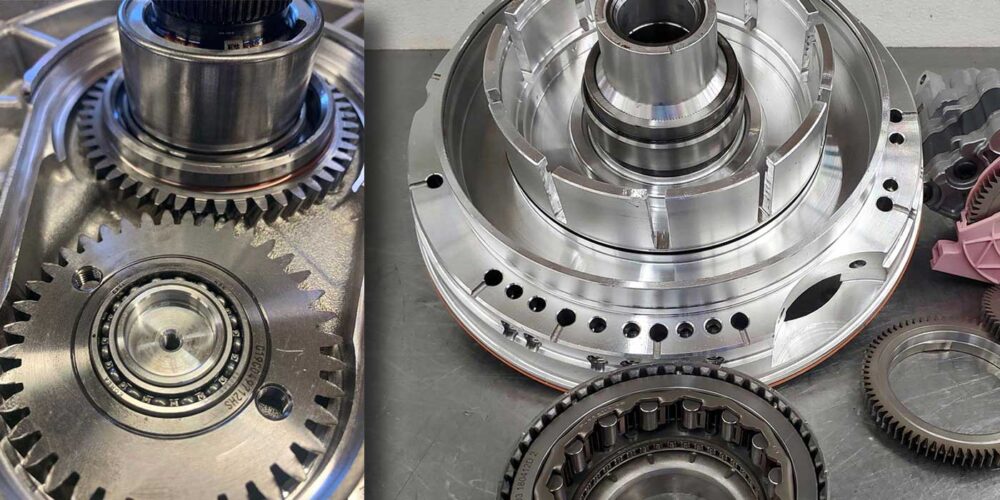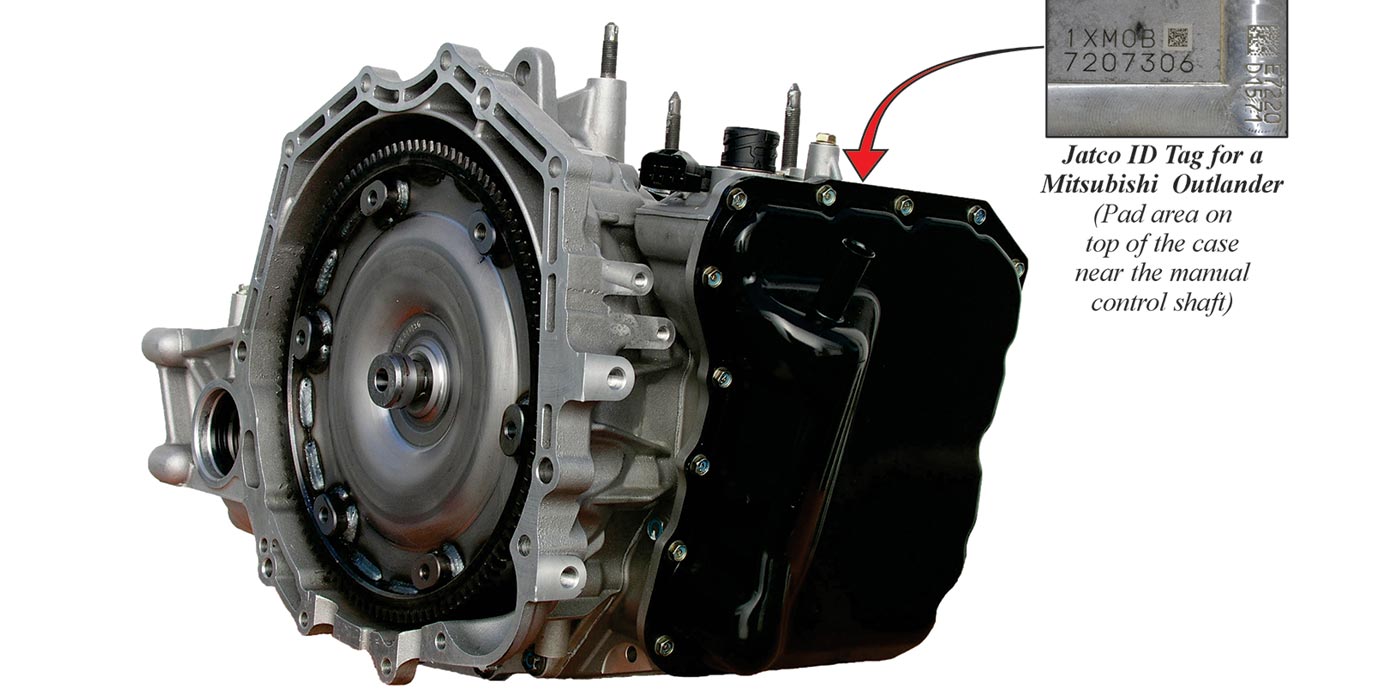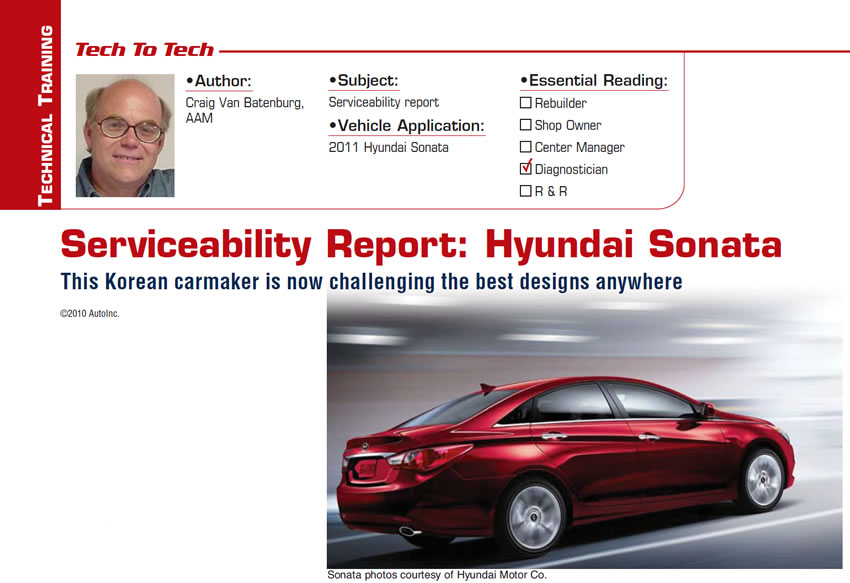
Tech to Tech
- Subject: Serviceability report
- Vehicle Application: 2011 Hyundai Sonata
- Essential Reading: Diagnostician
- Author: Craig Van Batenburg, AAM
This Korean carmaker is now challenging the best designs anywhere
In this article, we will examine the 2006 Sonata versus the 2011. It should also be noted that Hyundai has cooperated with the National Automotive Service Task Force in a thoughtful way. Hyundai and its other company, Kia, are the only car companies that post all their service information on their Web sites for free. Every wiring diagram, technical-service bulletin, body manual, you name it. Hyundai and Kia have shown, in this way, support for aftermarket shops like no other company.
Who is Hyundai?
The beginning of Hyundai Motor Co. dates to April 1946, when founder Ju-Yung Chung established Hyundai Auto Service in Seoul, South Korea, at the age of 31. The name Hyundai was chosen for its meaning, which in English translates to “modern,” but the first Hyundai I worked on in my shop was far from modern (more about that later). Ju-Yung Chung and his younger brother, Se-Yung Chung, later founded the current company in 1967.
In 1968 the company entered into a contract with Ford Motor Co. to assemble the Ford Cortina and Granada for the South Korean market and continued to produce them until 1976. Hyundai completed construction of the Ulsan plant in six months and achieved the shortest time to groundbreaking and earliest commercial production of any of Ford’s 118 plants. This partnership provided Hyundai with assembly knowledge, blueprints, technical specifications, production manuals and trained Hyundai engineers.
The 1986 Excel (also known as the Pony, Presto and a similar Mitsubishi Precis) was Hyundai’s first front-wheel-drive automobile and was produced until 1994.
Hyundai finally entered the U.S. automotive market in 1985 with the Excel, which was offered in two formats: a three-door hatchback and a sedan. In addition to a lengthy list of features, the Excel held a starting price of less than $5,000. After a few years these cars fell apart, and the Hyundai name was joked about by American technicians.
In 2002 Hyundai initiated its plan to open a manufacturing plant in the United States. Eventually, 1,744 acres of pasture in Montgomery, Ala., was selected for the site. The grand opening of the $1.1-billion factory occurred May 20, 2005, and was attended by thousands, including Alabama Gov. Bob Riley, President George W. Bush and Chairman Mong-Koo Chung.
While the factory employs more than 2,000 workers, about 72 suppliers have located throughout North America to support the new venture, creating more than 5,000 additional jobs. The 2-million-square-foot manufacturing plant includes a stamping facility, paint shop, vehicle-assembly shop, two-mile test track and an engine shop.
In May 2005, the facility marked the official start of production with its first salable 2006 Sonata. Hyundai Motor Manufacturing Alabama (HMMA) can produce 300,000 vehicles per year at full capacity, including the Sonata and Santa Fe. Using robotics, assembly methods and a team structure, the plant is acknowledged as the most automated in the world. As time went on, quality improved and Hyundai did its own design work. What took the Japanese car companies four decades, Hyundai did in two.

The Sonata
The Sonata was sold in Korea and other countries for years before coming to America. It was the fourth generation that came here in 1999. The European styling influence remained, and the design was acknowledged by members of the press as attractive and original. Four engine choices were offered, including 1.8L, 2.0L and 2.4L, and an impressive Delta 2.5L V-6 producing about 170 hp. This introduction coincided with the 10-year, 100,000-mile warranty in the United States.
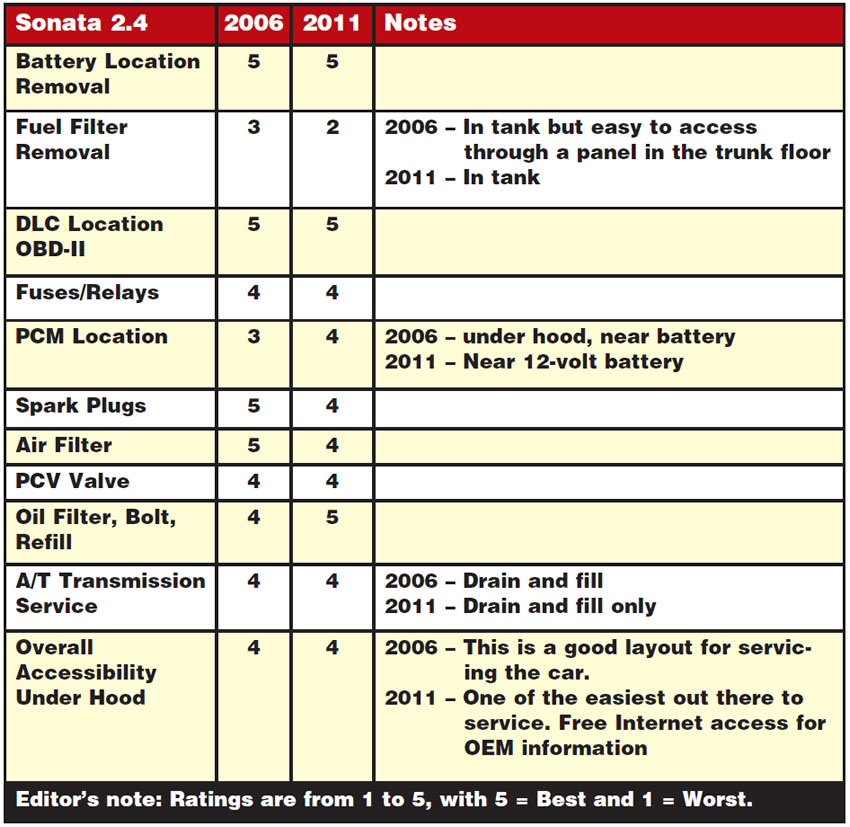
For the evaluation of serviceability, we will compare the 2.4-liter 2006 Hyundai Sonata GL with a four-speed automatic transmission with the 2011 version. The fifth-generation Sonata (NF project code) was launched in 2005 as a 2006 model incorporating competitive and industry-leading features. It was designed with the North American audience in mind and included design influences from Michigan and California. The Sonata was Hyundai’s first release reflecting a new focus on safety.
Reports indicated the company crashed 120 early Sonatas to perfect the structure and best engineer it to absorb and channel impact energy around the passenger cabin. It earned a five-star safety rating for both front and side impacts. Even base models include more standard safety features than any other car in a similar class, including head curtain airbags, electronic stability control, traction control, antilock brakes, brake-force distribution and active headrests.
Several engine choices were offered, including new aluminum Theta 2.0 and 2.4L engines (162 hp) and a new aluminum Lambda 3.3L V-6 (235 hp). Some reports at that time indicated a hybrid Sonata might be sold in 2007. That would eventually happen in 2010.
The problems associated with this model were seat latches, airbag deployment, brake-light switches that stick and lighting problems. All these items saw recalls that affected the 2006 Sonata with a 2.4 engine. Identifix reports many fixes on its Web site, including problems with the valve train, defective throttle-position sensors (TPS) and cold-weather freezing of the throttle shaft.
The fuel pump can be accessed through the trunk floor. This engine uses a timing belt that is fairly straightforward to replace. The 2.4 engine uses coil-on-plug (COP), and most everything you need to get to is in plain sight so service is relatively easy. Overall, this was a reliable and economical car to own. It helped create a good image for this brand.

2011 Sonata
The 2011 Sonata is already in dealership showrooms, and it is all new. The car is the best-looking Sonata ever made. The V-6 engine is gone, with a turbo 2.0 four-cylinder engine replacing it this fall, and the standard gas engine now has direct injection. A six-speed automatic is fitted if you opt out of the six-speed standard transmission. This is quite a car. The top of the line has a lot of features and compares quite well with any other car in its class and price range. Hyundai is on a roll. The company also enjoyed a small sales increase in 2009, when almost every car company had huge sales declines.
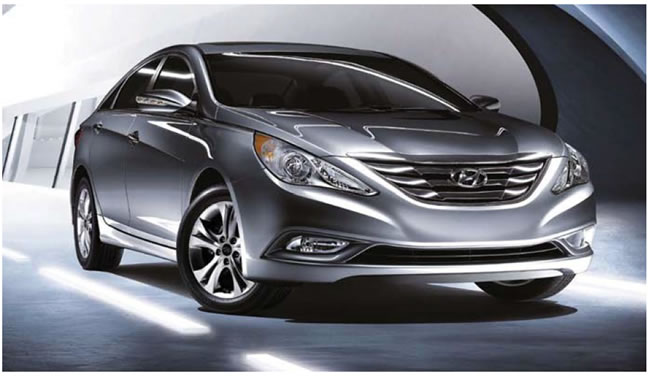
In April I attended the New York auto show press days with Deb, my wife, and the new Sonatas were there in force. Three new-car introductions took place, including the new 2.0 Turbo Sonata and the Blue Drive Sonata hybrid.
The hybrid version has a unique series/parallel system. Unlike the planetary gears used in Toyota/Ford systems, Hyundai uses a water-cooled, high-voltage starter/generator that is mounted where the alternator normally sits and starts the engine using a belt – not unlike the blue-cabled General Motors Corp. system. Then, a six-speed fully automatic is used with what I assume is a clutched, single brushless motor that can drive the car with the internal-combustion engine (ICE) up to 62 mph. A lithium-polymer battery is used, and the entire system is much lighter than any of the competition, mainly Ford Fusion and Toyota Camry hybrids. This new hybrid is designed by Hyundai. This is amazing, considering the first Hyundai that came to America was a Mitsubishi design and not a very good one. Watch for this new hybrid at the end of this year.
Sonata 2.4
The 2011 Sonata 2.4 looks like a car any technician can service without major headaches as long as the shop has high-speed wireless and the technician owns a laptop as well as a toolbox so you can get the repair information you need. Fixing this car should not pose any big problems as long as your scan tool works well with Hyundai models and re-flashing is done in house. Put this car on your list of services available to your customers. Hyundai has arrived.
2006
- Ups – It’s OK for the money and easy to fix. Make sure the recalls were done.
- Downs – This car has an extended warranty that confuses the owners into thinking everything is free. Take the time to explain what they can do at your shop so you get your fair share of the work. Owners need to be trained to take care of their cars. Hyundai marketed these cars to those who were often credit risks, so they may have little money for repairs and maintenance.
2011
- Ups – Better cars and a strong customer base. This should prove to be some of their best work to date.
- Downs – The old image of past problems still lingers, so keep working to convince owners to take care of their Hyundais properly.

Craig Van Batenburg, AAM, is the owner of the Automotive Career Development Center (ACDC), www.auto-careers.org, and delivers management and technical seminars nationwide. He formerly owned Van Batenburg’s Garage Inc. in Worcester, Mass., for more than 25 years. Van Batenburg is ASE master and L1 certified, with advanced skills in hybrid drive systems. You can reach him by e-mail at [email protected]
This copyrighted article is reprinted with the permission of AutoInc., the official publication of the Automotive Service Association (ASA). To learn more about ASA and its commitment to independent automotive-service and repair professionals, visit www.ASAshop.org or call 800-272-7467.
Sonata photos courtesy of Hyundai Motor Co.





